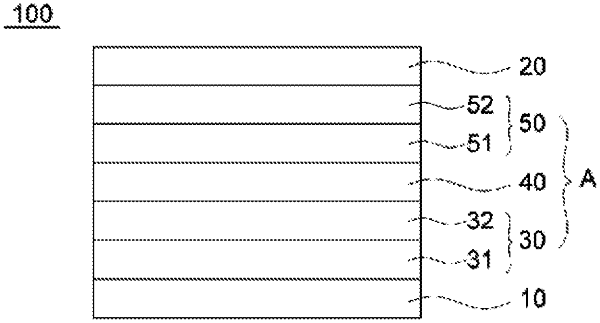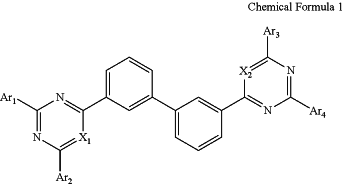| CPC H10K 50/16 (2023.02) [H10K 50/171 (2023.02); H10K 85/615 (2023.02); H10K 85/631 (2023.02); H10K 85/636 (2023.02); H10K 85/654 (2023.02); H10K 85/6572 (2023.02); H10K 85/6574 (2023.02); H10K 85/6576 (2023.02)] | 19 Claims |

|
1. An organic electroluminescent device, comprising:
a stack structure in which an anode, a hole transporting area; an emissive layer; an electron transporting area; and a cathode are sequentially stacked,
wherein the electron transporting area comprises an electron transporting layer and an electron injection layer,
wherein the electron transporting layer comprises a compound represented by the following Chemical Formula 1:
 wherein in Chemical Formula 1,
one of X1 and X2 is CR1 and the other thereof is N,
R1 is selected from the group consisting of hydrogen, deuterium, halogen, a cyano group, a C1 to C40 alkyl group, a C6 to C60 aryl group and a heteroaryl group having 5 to 60 nuclear atoms;
Ar1 to Ar4 are each independently selected from the group consisting of: a C1 to C40 alkyl group, a C2 to C40 alkenyl group, a C2 to C40 alkynyl group, a C3 to C40 cycloalkyl group, a heterocycloalkyl group having 3 to 40 nuclear atoms, a C6 to C60 aryl group, a heteroaryl group having 5 to 60 nuclear atoms, a C1 to C40 alkyloxy group, a C6 to C60 aryloxy group, a C1 to C40 alkylsilyl group, a C6 to C60 arylsilyl group, a C1 to C40 alkylboron group, a C6 to C60 arylboron group, a C6 to C60 arylphosphine group, a C6 to C60 arylphosphine oxide group and a C6 to C60 arylamine group, while a case where all of Ar1 to Ar4 are the same as each other is excluded, and
the alkyl group, the alkenyl group, the alkynyl group, the cycloalkyl group, the heterocycloalkyl group, the aryl group, the heteroaryl group, the alkyloxy group, the aryloxy group, the alkylsilyl group, the arylsilyl group, the alkylboron group, the arylboron group, the arylphosphine group, the arylphosphine oxide group and the arylamine group of R1 and Ar1 to Ar4 are each independently substituted or unsubstituted with one or more kinds of substituents selected from the group consisting of deuterium, halogen, a cyano group, a nitro group, a C2 to C40 alkenyl group, a C2 to C40 alkynyl group, a C3 to C40 cycloalkyl group, a heterocycloalkyl group having 3 to 40 nuclear atoms, a C1 to C40 alkyl group, a C6 to C60 aryl group, a heteroaryl group having 5 to 60 nuclear atoms, a C1 to C40 alkyloxy group, a C6 to C60 aryloxy group, a C1 to C40 alkylsilyl group, a C6 to C60 arylsilyl group, a C1 to C40 alkylboron group, a C6 to C60 arylboron group, a C6 to C60 arylphosphine group, a C6 to C60 arylphosphine oxide group and a C6 to C60 arylamine group, and when the substituents are plural in number, the substituents are the same as or different from each other,
with the proviso that the heteroaryl group having 5 to 60 nuclear atoms as R1 or Ar1 to Ar4 is not
 |